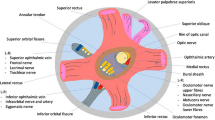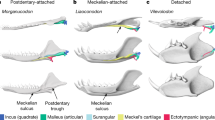Abstract
SZALAY1 has attributed to Forsyth Major2 the statement that the ethmoid bone appears in the medial orbital wall of many Madagascar prosimians. But in fact, an orbital exposure (os planum) of the ethmoid is known only in Cheirogaleus and Microcebus among Lemuriformes. As Jones3 and Kollman4 have demonstrated, the element which Forsyth Major mistook for an os planum is the pre-nasopalatine part of the palatine bone.
This is a preview of subscription content, access via your institution
Access options
Subscribe to this journal
Receive 51 print issues and online access
$199.00 per year
only $3.90 per issue
Buy this article
- Purchase on Springer Link
- Instant access to full article PDF
Prices may be subject to local taxes which are calculated during checkout
Similar content being viewed by others
References
Szalay, F. S., Nature, 230, 324 (1971).
Forsyth Major, C. I., Proc. Zool. Soc. Lond., 1, 9 (1901).
Jones, F. W., Proc. Zool. Soc. Lond., 1, 323 (1917).
Kollman, M., Mém. Soc. Linn. Normandie (Zool.), NS 1, 1 (1925).
Bolk, L., Verh. K. Akad. Wet., Amsterdam, 2 sectie, 20 (5), 1 (1919).
Simons, E. L., and Russell, D. E., Breviora, 127 (1960).
Cartmill, M., thesis, Univ. Chicago (1970).
Author information
Authors and Affiliations
Rights and permissions
About this article
Cite this article
CARTMILL, M. Ethmoid Component in the Orbit of Primates. Nature 232, 566–567 (1971). https://doi.org/10.1038/232566b0
Issue Date:
DOI: https://doi.org/10.1038/232566b0
Comments
By submitting a comment you agree to abide by our Terms and Community Guidelines. If you find something abusive or that does not comply with our terms or guidelines please flag it as inappropriate.



